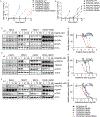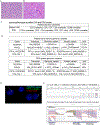Integration of Genomic Sequencing Drives Therapeutic Targeting of PDGFRA in T-Cell Acute Lymphoblastic Leukemia/Lymphoblastic Lymphoma
- PMID: 37725576
- PMCID: PMC10872648
- DOI: 10.1158/1078-0432.CCR-22-2562
Integration of Genomic Sequencing Drives Therapeutic Targeting of PDGFRA in T-Cell Acute Lymphoblastic Leukemia/Lymphoblastic Lymphoma
Abstract
Purpose: Patients with relapsed or refractory T-cell acute lymphoblastic leukemia (T-ALL) or lymphoblastic lymphoma (T-LBL) have limited therapeutic options. Clinical use of genomic profiling provides an opportunity to identify targetable alterations to inform therapy.
Experimental design: We describe a cohort of 14 pediatric patients with relapsed or refractory T-ALL enrolled on the Leukemia Precision-based Therapy (LEAP) Consortium trial (NCT02670525) and a patient with T-LBL, discovering alterations in platelet-derived growth factor receptor-α (PDGFRA) in 3 of these patients. We identified a novel mutation in PDGFRA, p.D842N, and used an integrated structural modeling and molecular biology approach to characterize mutations at D842 to guide therapeutic targeting. We conducted a preclinical study of avapritinib in a mouse patient-derived xenograft (PDX) model of FIP1L1-PDGFRA and PDGFRA p.D842N leukemia.
Results: Two patients with T-ALL in the LEAP cohort (14%) had targetable genomic alterations affecting PDGFRA, a FIP1-like 1 protein/PDGFRA (FIP1L1-PDGFRA) fusion and a novel mutation in PDGFRA, p.D842N. The D842N mutation resulted in PDGFRA activation and sensitivity to tested PDGFRA inhibitors. In a T-ALL PDX model, avapritinib treatment led to decreased leukemia burden, significantly prolonged survival, and even cured a subset of mice. Avapritinib treatment was well tolerated and yielded clinical benefit in a patient with refractory T-ALL.
Conclusions: Refractory T-ALL has not been fully characterized. Alterations in PDGFRA or other targetable kinases may inform therapy for patients with refractory T-ALL who otherwise have limited treatment options. Clinical genomic profiling, in real time, is needed for fully informed therapeutic decision making.
©2023 American Association for Cancer Research.
Conflict of interest statement
Conflicts of Interest:
YL is a current employee of Merck Pharmaceuticals. BGM is an employee of Blueprint Medicines. MPJ is a consultant to and shareholder of Schrodinger LLC, which licenses software used in this work. KS previously consulted for Kronos Bio, Astra-Zeneca, and Auron Therapeutics, receives grant funding from Novartis and Kronos Bio for an unrelated project and holds stock options with Auron Therapeutics.
Figures





References
-
- Pikman Y, Tasian SK, Sulis ML, Stevenson K, Blonquist TM, Apsel Winger B, et al. Matched Targeted Therapy for Pediatric Patients with Relapsed, Refractory, or High-Risk Leukemias: A Report from the LEAP Consortium. Cancer Discov 2021;11(6):1424–39 doi 10.1158/2159-8290.Cd-20-0564. - DOI - PMC - PubMed
-
- Harris MH, DuBois SG, Glade Bender JL, Kim A, Crompton BD, Parker E, et al. Multicenter Feasibility Study of Tumor Molecular Profiling to Inform Therapeutic Decisions in Advanced Pediatric Solid Tumors: The Individualized Cancer Therapy (iCat) Study. JAMA Oncology 2016;2(5):608–15 doi 10.1001/jamaoncol.2015.5689. - DOI - PubMed
-
- Massard C, Michiels S, Ferté C, Le Deley M-C, Lacroix L, Hollebecque A, et al. High-Throughput Genomics and Clinical Outcome in Hard-to-Treat Advanced Cancers: Results of the MOSCATO 01 Trial. Cancer Discovery 2017;7(6):586–95 doi 10.1158/2159-8290.Cd-16-1396. - DOI - PubMed
Publication types
MeSH terms
Substances
Associated data
Grants and funding
LinkOut - more resources
Full Text Sources
Medical
Research Materials
Miscellaneous

